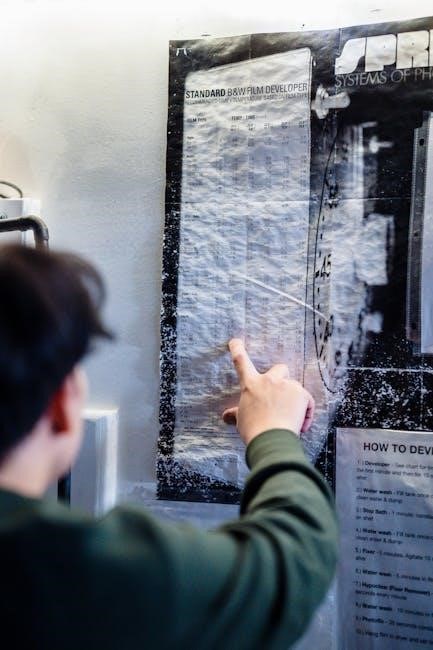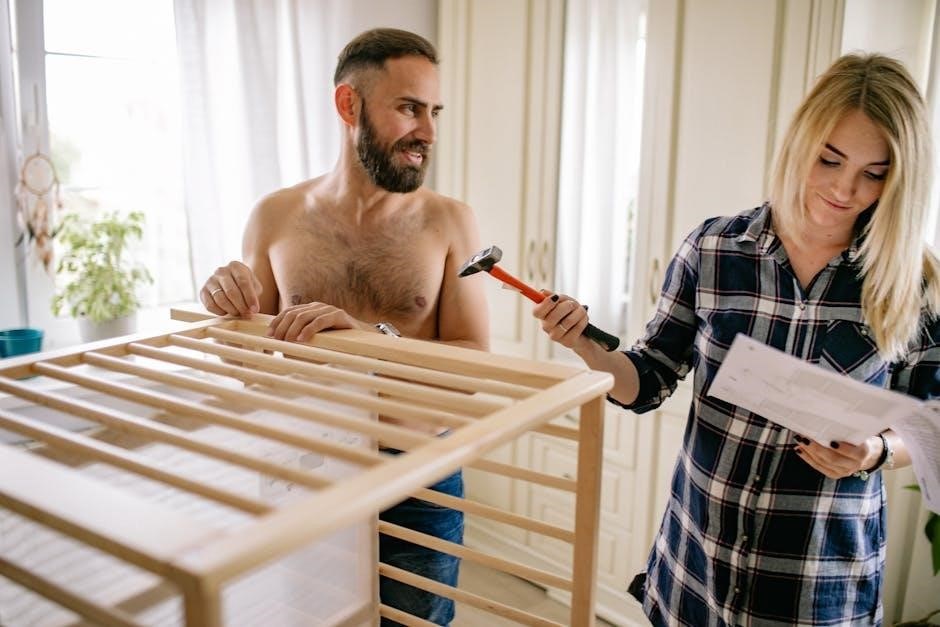
The Honeywell RTH221B is a programmable thermostat designed for efficient temperature control in homes. It offers compatibility with various heating and cooling systems, ensuring optimal performance and energy savings. The thermostat features a simple interface for scheduling and adjusting settings, making it user-friendly for homeowners seeking precise climate management. Proper installation and setup, guided by the instruction manual, are essential for maximizing its functionality and ensuring reliable operation.
1.1 Overview of the RTH221B Model
The Honeywell RTH221B is a 1-week programmable thermostat designed for compatibility with various heating and cooling systems, including gas, oil, and electric furnaces, as well as central air conditioners. Its intuitive interface allows users to set daily schedules for precise temperature control, enhancing comfort and energy efficiency. The thermostat is battery-powered and features a straightforward installation process, making it a reliable choice for homeowners seeking to regulate their environment effectively.
1.2 Importance of the Instruction Manual
The instruction manual for the Honeywell RTH221B is essential for proper installation, operation, and troubleshooting. It provides detailed guidance on setting up the thermostat, configuring schedules, and understanding advanced features. The manual also includes safety precautions and warranty information, ensuring users can maximize the thermostat’s functionality while adhering to manufacturer recommendations. Referencing the manual helps avoid common issues and ensures optimal performance, making it a crucial resource for all users.
Identifying System Type
Identifying your HVAC system type ensures proper thermostat compatibility. The RTH221B works with gas, oil, electric furnaces, and central air systems, as detailed in the manual.
2.1 Compatible Systems (Gas, Oil, Electric Furnace, Central Air Conditioner, etc.)
The Honeywell RTH221B thermostat is compatible with various HVAC systems, including gas, oil, and electric furnaces, as well as central air conditioners. It also supports hot water systems, with or without pumps, and millivolt systems. This versatility ensures it can integrate seamlessly with most home heating and cooling setups. Proper installation and configuration, as outlined in the manual, are crucial for optimal performance and energy efficiency across all compatible systems.
2.2 Mercury Recycling Notice
The Honeywell RTH221B thermostat does not contain mercury, making it environmentally friendly. However, if replacing an older mercury-containing thermostat, proper disposal is essential. Users are advised to contact local waste management authorities for guidance on mercury recycling and safe disposal procedures. Adhering to these guidelines ensures compliance with environmental regulations and helps protect the ecosystem. Always follow recommended practices for handling and recycling mercury-containing products to minimize ecological impact.

Customer Assistance
Honeywell provides dedicated support for RTH221B users, offering resources like manuals, troubleshooting guides, and contact options to address queries and ensure smooth operation of the thermostat.
3.1 Contact Information for Honeywell Customer Relations
For assistance with the Honeywell RTH221B, contact Honeywell Customer Relations at 1-800-468-1502. In Canada, reach out to Retail Products ON15-02H, Honeywell Limited, 35 Dynamic Drive, Scarborough, Ontario M1V4Z9. Visit yourhome.honeywell.com for additional support resources and troubleshooting guides. Ensure to have your model number ready when seeking help for efficient service.
3.2 Online Resources and Support
Honeywell provides extensive online resources for the RTH221B thermostat, including downloadable manuals, troubleshooting guides, and FAQs. Visit yourhome.honeywell.com for detailed instructions, installation tips, and programming assistance. The website offers easy access to user manuals, ensuring you can resolve issues or learn new features at your convenience. Online support is available 24/7, making it simple to find the help you need without waiting for customer service.

Installation
Installation of the Honeywell RTH221B thermostat involves turning off power, removing the old thermostat, and properly wiring the new device. Follow the manual for safe and correct setup.
4.1 Installing Batteries
Installing batteries in the Honeywell RTH221B thermostat is straightforward. Use two fresh AA alkaline batteries for optimal performance. Open the battery compartment on the rear of the thermostat. Ensure the batteries are inserted with the correct polarity, as indicated by the symbols inside the compartment. Avoid mixing old and new batteries or using rechargeable types. Once installed, close the compartment securely. The thermostat will now power on, allowing you to proceed with setup and programming. Proper battery installation ensures reliable operation.
4.2 Mounting the Thermostat
Before mounting the Honeywell RTH221B thermostat, turn off power to the HVAC system at the circuit breaker. Remove the old thermostat and gently pull the wires free. Label the wires for identification. Attach the mounting bracket to the wall, ensuring it is level. Align the thermostat with the bracket and secure it. Reconnect the wires to the appropriate terminals, matching the labels. Restore power and test the thermostat to ensure proper operation. Proper mounting ensures accurate temperature control and system efficiency.
4.3 Wiring Instructions
Ensure the power to your HVAC system is off before proceeding. Identify and label the wires from your old thermostat. Match each wire to the corresponding terminal on the Honeywell RTH221B, following the manual’s wiring diagram. Common terminals include R (power), W (heat), Y (cool), G (fan), C (common), and O/B (heat pump). Securely connect the wires to the correct terminals. If your system lacks certain wires, cap or tape them to prevent short circuits. Double-check connections before restoring power to ensure proper functionality and safety.
4.4 Setting the Fan Operation Switch
The fan operation switch on the Honeywell RTH221B thermostat allows you to control the fan’s operation. Set the switch to “Auto” for automatic fan operation, which runs only when heating or cooling. For continuous fan operation, set it to “On.” Ensure the switch is correctly positioned based on your preference. Refer to the manual for specific guidance, as settings may vary slightly depending on your system type. Proper adjustment ensures efficient airflow and optimal comfort in your home. Always consult the manual for precise instructions.

Initial Setup
The initial setup involves configuring basic settings like time, day, and temperature preferences. Ensure accurate time and date for proper scheduling. Set temperature ranges to match your comfort needs; Activate built-in compressor protection if applicable. Refer to the manual for detailed steps to complete the setup successfully.
5.1 Setting the Time and Day
Setting the correct time and day is essential for proper thermostat operation. Press the “Set” button to access the time menu. Use the up and down arrows to adjust the current time and select AM/PM. Ensure the date is accurate for scheduling. The thermostat will display the current time once set. Accurate time ensures your temperature schedule runs correctly. Refer to the manual for detailed steps to avoid errors during setup.
5.2 Configuring Temperature Settings
Configuring temperature settings on the Honeywell RTH221B allows you to set desired heating and cooling levels. Press the “Set” button and use the up/down arrows to adjust the temperature. The thermostat displays the current setpoint, which you can change manually or through programmed schedules. Ensure the temperature range is within acceptable limits for your system. Programming temperature settings helps maintain comfort and energy efficiency, allowing you to customize settings for home, away, and sleep periods. Refer to the manual for detailed temperature configuration steps.
5.3 Built-in Compressor Protection
The Honeywell RTH221B thermostat features built-in compressor protection to prevent short-cycling, which can damage your cooling system. This feature ensures the compressor operates within a safe time frame, reducing wear and tear. The thermostat includes a minimum on-time setting to maintain efficient operation. It also incorporates adaptive intelligent recovery, which learns your system’s performance to optimize cooling. These protections help extend the lifespan of your HVAC equipment and ensure reliable, energy-efficient operation. Enable these settings during initial setup for optimal performance.

Programming the Thermostat
Program your RTH221B to create a daily schedule, optimizing temperature settings for energy efficiency. Easily override the schedule for temporary adjustments, ensuring comfort and convenience year-round.
6.1 Creating a Daily Schedule
To create a daily schedule on the Honeywell RTH221B, navigate to the programming menu. Select the desired days and set the preferred temperatures for morning, day, evening, and night. Use the touchscreen or buttons to adjust the schedule as needed, ensuring energy efficiency and comfort. Save the settings to activate the schedule, which will automatically adjust the temperature throughout the day based on your preferences.
6.2 Overriding the Program Schedule
To override the program schedule, press the touchscreen or buttons to manually adjust the temperature. This temporary override will hold the selected temperature until the next scheduled period begins. Use the “Hold” feature to maintain the current temperature indefinitely or until you cancel it. Overriding does not alter the programmed schedule, allowing the thermostat to resume its pre-set temperatures at the next scheduled time automatically.
Advanced Features
The Honeywell RTH221B offers advanced features like compressor protection to prevent damage and battery maintenance alerts for longevity. These features ensure optimal performance and system protection.
7.1 Advanced Installation Options
The Honeywell RTH221B thermostat offers advanced installation options to accommodate various HVAC systems. It supports gas, oil, electric furnaces, and central air conditioners, ensuring flexibility for different setups. The thermostat also works with millivolt systems, making it versatile for specialized installations. For proper setup, it’s crucial to follow the wiring instructions carefully, ensuring all connections are secure. Advanced features like built-in compressor protection and fan operation switches enhance performance. Detailed wiring diagrams in the manual guide users through complex configurations, ensuring safe and efficient installation.
7.2 Battery Maintenance
The Honeywell RTH221B thermostat requires minimal battery maintenance to ensure reliable operation. Use high-quality alkaline batteries (AA type) for optimal performance. Avoid mixing old and new batteries or using rechargeable ones. Replace batteries when the display shows a low battery indicator or the thermostat stops responding. Turn off the thermostat before replacing batteries to prevent system glitches. Properly dispose of used batteries, following local recycling guidelines. Regular battery checks and replacements will maintain consistent temperature control and prevent unexpected system shutdowns.

Troubleshooting
Identify common issues like incorrect temperature display or unresponsive controls. Check wiring connections, ensure proper battery installation, and restart the system if necessary to resolve most problems quickly.
8.1 Common Issues and Solutions
Common issues with the Honeywell RTH221B include display malfunctions, unresponsive controls, or incorrect temperature readings. Ensure batteries are properly installed and connections are secure. If the display is blank, check power sources and wiring. For temperature inaccuracies, recalibrate the thermostat or reset it by removing batteries for a few seconds. Always refer to the manual for specific troubleshooting steps to resolve issues efficiently and maintain optimal performance.
8.2 Error Codes and Their Meanings
The Honeywell RTH221B may display error codes like E1, E2, or E3, indicating issues such as sensor malfunctions or communication errors. E1 often relates to temperature sensor problems, while E2 may signal a faulty connection. E3 could indicate a system communication failure. Refer to the manual for specific code meanings and solutions. Resetting the thermostat or checking wiring connections often resolves these issues. Consulting the error code section ensures quick troubleshooting and restores normal operation.
Safety and Compliance
Ensure compliance with safety guidelines and regulations when installing and operating the Honeywell RTH221B; Adhere to proper disposal and recycling instructions to protect the environment and ensure safe operation.
9.1 Mercury Recycling Guidelines
The Honeywell RTH221B thermostat contains mercury, requiring proper handling and recycling. To ensure environmental safety, follow local regulations for disposal. Contact your waste management authority for guidance on recycling mercury-containing devices. Properly seal the thermostat in an airtight container to prevent mercury exposure. Do not dispose of it in regular trash. Adhere to these guidelines to protect the environment and comply with legal requirements. Detailed instructions are provided in the instruction manual for safe handling and recycling.
9.2 Proper Disposal Instructions
Proper disposal of the Honeywell RTH221B thermostat is crucial for environmental protection. Remove batteries before disposal and package the device securely to prevent damage. Do not dispose of the thermostat in regular trash, as it contains electronic components. Instead, take it to an authorized e-waste recycling center or participate in local electronics recycling programs. Follow all local regulations and guidelines to ensure safe and responsible disposal. This helps prevent hazardous materials from entering landfills and protects the environment.

Customer Support and Warranty
Honeywell offers comprehensive customer support and a robust warranty program for the RTH221B thermostat. For assistance, contact Honeywell Customer Relations at 1-800-468-1502 or write to 1985 Douglas Dr, Golden Valley, MN 55422. Additional support is available online through Honeywell’s official website, ensuring prompt resolution of any issues. The warranty covers defects in materials and workmanship, providing peace of mind for users.
10.1 Warranty Information
The Honeywell RTH221B thermostat is backed by a limited warranty that covers defects in materials and workmanship. The warranty period varies depending on the product and usage. For residential use, the thermostat is typically covered for a minimum of one year from the date of purchase. For detailed warranty terms, refer to the instruction manual or contact Honeywell Customer Relations at 1-800-468-1502. Proper registration and installation are recommended to ensure warranty validity. Honeywell also provides recycling guidelines for mercury-containing thermostats, emphasizing environmental responsibility.
10.2 Contacting Honeywell Support
For assistance with the Honeywell RTH221B thermostat, contact Honeywell Customer Relations at 1-800-468-1502. In Canada, reach out to Honeywell Limited at 35 Dynamic Drive, Scarborough, Ontario M1V4Z9. Visit yourhome.honeywell.com for online resources, troubleshooting guides, and programming support. The support team is available to address installation, operation, or warranty-related queries, ensuring seamless functionality of your thermostat.
The Honeywell RTH221B thermostat offers a reliable and efficient solution for home temperature control. With its programmable features and compatibility with various systems, it ensures comfort and energy savings. By following the instruction manual, users can optimize its performance and troubleshoot common issues. Honeywell’s customer support and comprehensive resources further enhance the user experience, making the RTH221B a practical choice for modern households seeking precise climate management.




